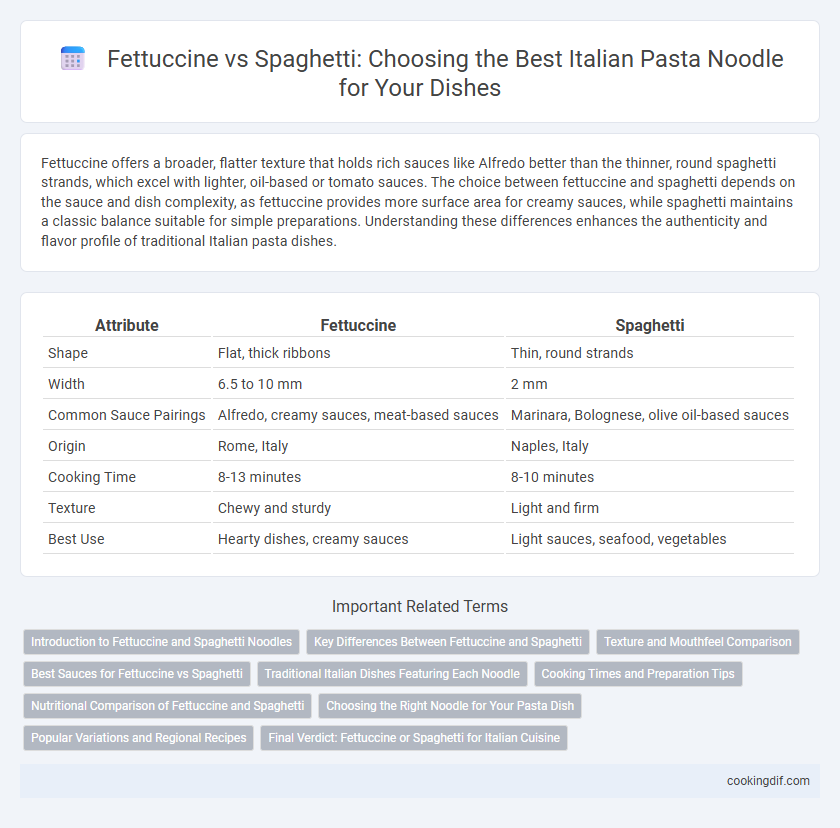Fettuccine offers a broader, flatter texture that holds rich sauces like Alfredo better than the thinner, round spaghetti strands, which excel with lighter, oil-based or tomato sauces. The choice between fettuccine and spaghetti depends on the sauce and dish complexity, as fettuccine provides more surface area for creamy sauces, while spaghetti maintains a classic balance suitable for simple preparations. Understanding these differences enhances the authenticity and flavor profile of traditional Italian pasta dishes.
Table of Comparison
| Attribute | Fettuccine | Spaghetti |
|---|---|---|
| Shape | Flat, thick ribbons | Thin, round strands |
| Width | 6.5 to 10 mm | 2 mm |
| Common Sauce Pairings | Alfredo, creamy sauces, meat-based sauces | Marinara, Bolognese, olive oil-based sauces |
| Origin | Rome, Italy | Naples, Italy |
| Cooking Time | 8-13 minutes | 8-10 minutes |
| Texture | Chewy and sturdy | Light and firm |
| Best Use | Hearty dishes, creamy sauces | Light sauces, seafood, vegetables |
Introduction to Fettuccine and Spaghetti Noodles
Fettuccine and spaghetti are two iconic Italian pasta varieties distinguished by their shape and texture; fettuccine features flat, thick ribbons typically made from egg pasta, perfect for rich, creamy sauces like Alfredo. Spaghetti is a long, thin cylindrical noodle made from durum wheat semolina, commonly paired with tomato-based sauces such as marinara. Both noodles offer unique culinary experiences, with fettuccine providing a hearty bite and spaghetti a lighter, more versatile profile.
Key Differences Between Fettuccine and Spaghetti
Fettuccine is a flat, ribbon-like pasta typically about 6.5 to 10 millimeters wide, offering a broader surface that holds rich, creamy sauces well. Spaghetti is a thin, cylindrical noodle approximately 2 millimeters in diameter, making it ideal for lighter tomato-based or oil-based sauces. The texture and sauce adherence differ significantly, with fettuccine providing a chewier bite and more sauce retention compared to the delicate and smooth texture of spaghetti.
Texture and Mouthfeel Comparison
Fettuccine offers a broader, flatter surface that provides a chewy, substantial texture, ideal for holding thicker sauces like Alfredo, enhancing the creamy mouthfeel. Spaghetti features a thinner, cylindrical shape that delivers a light, firm bite and a smoother mouthfeel, perfectly suited for lighter, oil-based or tomato sauces. The distinct textures create contrasting sensory experiences, with fettuccine presenting a hearty chew and spaghetti providing a delicate snap.
Best Sauces for Fettuccine vs Spaghetti
Fettuccine pairs exceptionally well with rich, creamy sauces such as Alfredo and carbonara, as its flat, thick texture holds heavier ingredients effectively. Spaghetti, being thinner and round, excels with light tomato-based sauces like marinara or aglio e olio, allowing the noodles to maintain a delicate balance without overpowering the sauce. Choosing the right sauce type enhances the pasta experience by complementing the noodle's shape and texture.
Traditional Italian Dishes Featuring Each Noodle
Fettuccine is a flat, thick pasta traditionally used in rich, creamy dishes like Fettuccine Alfredo and Fettuccine Carbonara, highlighting its ability to hold heavy sauces. Spaghetti, a long, thin, cylindrical noodle, forms the base of classic Italian dishes such as Spaghetti alla Carbonara, Spaghetti Bolognese, and Spaghetti Aglio e Olio, prized for its versatility with both light and hearty sauces. Each noodle type defines its respective dish's texture and flavor profile, reinforcing their roles in authentic Italian cuisine.
Cooking Times and Preparation Tips
Fettuccine typically requires 8 to 10 minutes to cook al dente, while spaghetti cooks faster, usually within 7 to 9 minutes. To prevent fettuccine from sticking together, stir gently during the first few minutes and use a large pot with ample water. For spaghetti, tossing immediately after draining with olive oil or sauce ensures even coating and prevents clumping.
Nutritional Comparison of Fettuccine and Spaghetti
Fettuccine and spaghetti both offer similar calorie content, typically around 200 calories per cooked cup, but fettuccine tends to have slightly higher protein due to its wider, thicker shape. Spaghetti provides marginally more carbohydrates and often contains less fat, making it a lighter choice for calorie-conscious consumers. Nutritional differences between the two noodles are minimal, with variations primarily influenced by portion size and added sauces rather than the pasta type itself.
Choosing the Right Noodle for Your Pasta Dish
Fettuccine's flat and wide shape holds rich, creamy sauces like Alfredo better than spaghetti, which excels with lighter, oil-based sauces or tomato-based recipes due to its thin, round strands. The texture of fettuccine provides a hearty bite ideal for thick ragus, while spaghetti's versatility suits both simple and complex preparations. Choosing between fettuccine and spaghetti depends on balancing sauce consistency with noodle texture to enhance flavor absorption and overall dish harmony.
Popular Variations and Regional Recipes
Fettuccine, originating from Emilia-Romagna, is widely known for its thick, flat shape that pairs excellently with rich, creamy sauces like Alfredo and Bolognese, often featured in northern Italian cuisine. Spaghetti, a thin, round noodle, is a staple across Italy, particularly in southern regions such as Naples, where it complements tomato-based sauces like marinara and seafood dishes in recipes like Spaghetti alle Vongole. Popular variations of these noodles highlight the diversity of Italian pasta traditions, with fettuccine recipes emphasizing rich, hearty flavors and spaghetti offering lighter, tangier options ideal for a wide range of regional specialties.
Final Verdict: Fettuccine or Spaghetti for Italian Cuisine
Fettuccine offers a broader, flat shape ideal for creamy, rich sauces like Alfredo, enhancing flavor absorption and texture in Italian dishes. Spaghetti's thin, cylindrical form pairs best with lighter, tomato-based or olive oil sauces, delivering a classic, versatile experience. Choosing between fettuccine and spaghetti ultimately depends on the sauce and desired eating experience, with fettuccine suited for hearty, creamy meals and spaghetti favored for simple, traditional flavors.
Fettuccine vs Spaghetti for Italian pasta noodles Infographic

 cookingdif.com
cookingdif.com